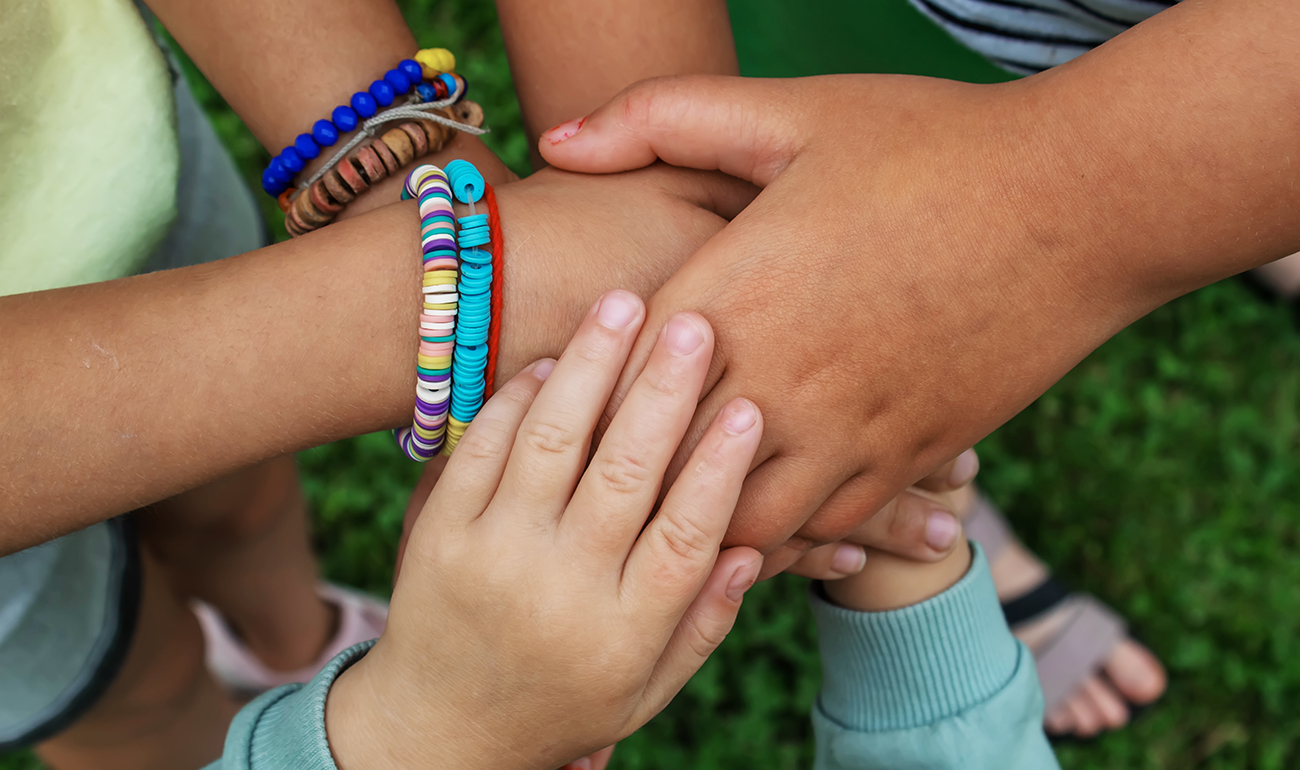
Children and Violence
Resource site developed from the course CDE 498: Children and Violence
Violence has always been a part of the human experience, manifesting in various forms such as war, child abuse, murder, and schoolyard bullying. It often impacts children, who may be innocent victims or, in some cases, perpetrators. Researchers are increasingly interested in the effects of violence on children, with psychologists, sociologists, family scientists, and educators seeking ways to prevent violence or reduce its impact. The goal is to help children lead positive and fulfilling lives.
This site offers resources for those interested in exploring topics related to children and violence. It was developed from the course "CDE 498: Children and Violence." We hope this page provides helpful access to the complex issue of children and violence.
Contact us:
Faculty Supervisor:
Denise Bodman, [email protected]
Graduate Students:
Gabrielle Murillo, [email protected]
Kyrie Dukepoo, [email protected]
Jordan Romeo, [email protected]
Lily Tran, [email protected]
Explore topics:

Familicide is a tragic act where someone kills members of their own family—most often a man who takes the lives of his partner and children before ending his own life (3,6).
Though rare, these heartbreaking events have occurred in places like the U.S., Canada, and Romania (1,2,8).
Experts believe familicide may be linked to factors such as:
- A history of abuse or violence (5,7)
- Mental health challenges (5,7)
- Substance misuse (5,7)
- Relationship or financial troubles (5,7)
- Easy access to guns (5,7)
News coverage often focuses on the person who caused the harm rather than the victims and can sometimes include inaccurate information (4,6).
By learning to recognize warning signs and offering support early, we can make a real difference in preventing these tragedies and protecting families.
Additional Information:
Familicide: When Domestic Abusers Kill Their Families and Sometimes, Themselves
https://www.domesticshelters.org/articles/identifying-abuse/familicide-when-domestic-abusers-kill-their-families-and-sometimes-themselves
Domestic Shelters explain familicide terms, warning signs in a partner that can lead to a familicide, and steps to take if a person is in danger.
Men Who Murder Their Families: What the Research Tells Us
https://www.ojp.gov/pdffiles1/nij/230412.pdf
The National Institute of Justice discusses characteristics of a person who commits familicide. This is typically men who are possessive, have access to weapons, and experience economic or family problems.
Understanding the Far-Reaching Impact of Familicide
https://news.nau.edu/understanding-far-reaching-impact-familicide/
The Northern Arizona University website explains that although familicide is rare, it heavily impacts communities. As more research is conducted on these types of crimes, the more support and knowledge we can provide to identify offenders and prevent future tragedies.
Family Violence Statistics: Including Statistics on Strangers and Acquaintances
https://bjs.ojp.gov/content/pub/pdf/fvs03.pdf
The U.S. Department of Justice provides an overview of data on family violence within the United States, including information on familicide.
The Economic Factor in the Rash of Murder-Suicides
https://www.psychologytoday.com/nz/blog/crimes-of-violence/201009/the-economic-factor-in-the-rash-of-murder-suicides
Psychology Today discusses that economic factors, especially after the 2008 recession, have played a significant part in familicide and murder-suicide cases.
References
- Armeanu, A. (2020). Familicide: Psychological and social characteristics of the aggressors. A case study. In Proceedings of the 19th International RAIS Conference on Social Sciences and Humanities (pp. 200-206). Scientia Moralitas Research Institute. https://zenodo.org/records/4268802
- Chen, D. (2024). ‘Familicide’ very rarely happens without warning signs, say domestic violence researchers. CBC News. https://www.cbc.ca/news/canada/windsor/familicide-domestic-violence-murder-suicide-walsh-harrow-1.7259570
- Diaz, M. L., Toohy, K., Fernandez, K., Huff-Corzine, L., & Reckdenwald, A. (2022). Out of sight, out of mind: An analysis of family mass murder offenders in the US, 2006-2017. Journal of Mass Violence Research, 1(1), 25-43. https://doi.org/10.53076/JMVR82831
- Galvin, A., Quinn, F., & Cleary, Y. (2023). Shaping the ‘inexplicable’: A social constructionist analysis of news reporting of familicide-suicide. Journalism, 24(7). https://doi.org/10.1177/14648849211063265
- Johnson, C. H. (2023). Familicide as a form of abuse. In Parveen, A. & Rogers, M. M. (Eds.), Gender-Based Violence: A Comprehensive Guide (pp. 153-165). Springer. https://www.researchgate.net/profile/Sadiq-Bhanbhro-2/publication/371233864_Honour_Crimes/links/647f3e30b3dfd73b77688d3f/Honour-Crimes.pdf
- Liem, M., Levin, J., Holland, C., & Fox, J. A. (2013). The nature and prevalence of familicide in the United States, 2000–2009. Journal of Family Violence, 28(4), 351–358. https://doi.org/10.1007/s10896-013-9504-2
- Mailloux, S. (2014). Fatal families: Why children are killed in familicide occurrences. Journal of Family Violence, 29(8), 921–926. https://doi.org/10.1007/s10896-014-9643-0
- Romero, D. (2025). Family of 4, including a 7-month old and a 6-year-old, dead in Montana murder-suicide. NBC News. https://www.nbcnews.com/news/us-news/family-4-7-month-old-6-year-old-dead-montana-murder-suicide-rcna206391
Spanking and Corporal Punishment

One of the most talked-about parenting topics is spanking, also called corporal punishment. For many years, researchers have studied spanking and how it affects kids. What the research shows is that spanking hurts brain development.
Spanking can cause:
- Increased aggression (4)
- Problems in school (4)
- A higher chance of mental health issues (1)
- Future drug and alcohol abuse (1)
- Violence in future relationships (6)
Children who are spanked less do better overall, especially when their parents are warm and loving (2). Stress can make it hard for parents to stay calm when dealing with their children’s behavior (5). Parenting classes and community groups can be helpful. This can help parents feel like they are not alone and more likely to use positive ways to guide their children (3). It’s easier to not spank when friends, family, and neighbors agree that spanking is harmful (3). The good news is that it’s never too late for parents to try new ways of guiding their children. Making these changes can create healthier, happier families.
Additional Resources for Parents:
Zero to Three
https://www.zerotothree.org/resources/positive-parenting/
Zero to Three covers a wide range of topics and serves as a valuable resource for positive parenting, including specific strategies, their benefits, and practical tips for managing stress.
CDC – Positive Parenting Tips
The CDC offers positive parenting tips for different age groups and information about child development, safety, and health.
https://www.cdc.gov/child-development/positive-parenting-tips/index.html
Healthy Children – American Academy of Pediatrics
https://www.healthychildren.org
The AAP parenting website provides practical information for parents about managing their children’s behavior and summarizes some of the research about spanking and its effects on development.
Harvard’s Center on the Developing Child
https://developingchild.harvard.edu/
The Center on the Developing Child offers resources about the science of child development, child mental health, and stress and resilience.
National Initiative to End Corporal Punishment
https://www.endphysicalpunishment.org/
The NIECP website includes insights into the research surrounding the effects of spanking, along with effective and culturally sensitive strategies for managing challenging behaviors.
References
Afifi, T., Ford, D., Gershoff, E., Merrick, M., Grogan-Kaylor, A., Ports, K., MacMillan, H., Holden, G., Taylor, C., Lee, S., & Bennett, R.P. (2017). Spanking and adult mental health impairment: The case for the designation of spanking as an adverse childhood experience. Child Abuse & Neglect, 71, 24-31. https://doi.org/10.1016/j.chiabu.2017.01.014.
Alampay L. P., Godwin, J., Lansford, J. E., Bombi, A. S., Bornstein, M. H., Chang, L., Kirby, D.-D., Giunta, L. D., Dodge, K. A., Malone, P. S., Oburu, P., Pastorelli Concetta, Skinner, A. T., Sorbring Emma, Tapanya Sombat, Tirado Liliana M Uribe, Zelli Arnaldo, Al-Hassan, S. M., & Bacchini Dario. (2017). Severity and justness do not moderate the relation between corporal punishment and negative child outcomes. International Journal of Behavioral Development, 41(4), 491–502. https://doi.org/10.1177/0165025417697852
Fleckman, J.M., Taylor, C.A., Theall, K.P., Andrinopoulos, K. (2018). Perceived social norms in the neighborhood context: The role of perceived collective efficacy in moderating the relation between perceived injunctive norms and use of corporal punishment. Child Adolescent Social Work Journal 36, 29–41. https://doi.org.ezproxy1.lib.asu.edu/10.1007/s10560-018-0581-1
Gershoff, E. T., Lansford, J. E., Sexton, H. R., Davis-Kean, P., & Sameroff, A. J. (2012). Longitudinal links between spanking and children’s externalizing behaviors in a national sample of White, Black, Hispanic, and Asian American families. Child Development, 83(3), 838–843. https://doi.org/10.1111/j.1467-8624.2011.01732.x
MacKenzie, M. J., Nicklas, E., Brooks-Gunn, J., & Waldfogel, J. (2011). Who spanks infants and toddlers? Evidence from the fragile families and child well-being study. Children and Youth Services Review, 33(8), 1364–1373. https://doi.org/10.1016/j.childyouth.2011.04.007
Temple, J. R., Choi, H. J., Reuter, T., Wolfe, D., Taylor, C. A., Madigan, S., & Scott, L. E. (2018). Childhood corporal punishment and future perpetration of physical dating violence. The Journal of Pediatrics, 194, 233–237. https://doi.org/10.1016/j.jpeds.2017.10.028


